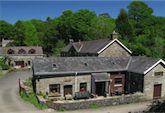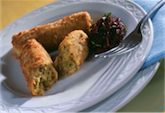Traditionally, the cooking styles, traditions and recipes associated with Wales are characterised by simplicity of approach and reliance on the high quality of natural produce – bread, cheese, milk, cream, bolied vegetables, roasted and stewed meats and freshwater and saltwater fish all feature heavily in traditional Welsh food.
So what on earth are faggots and rissoles, and what are they doing on the menu in this curious land where cheese on toast is the national dish, boys pin large onions to their chests once a year, and it’s ok to eat seaweed instead of corn flakes?
Faggots probably vie with laverbread as one of the great unknown and probably under-tried foods of Wales. Made from offal, usually liver and perhaps a touch of heart, with herbs, suet and breadcrumbs, these savoury ducks, as they are sometimes called, are not a snack for the gourmand of faint heart or for carrot-chomping vegetarians. Formerly a miner’s lunch, the balls of offally delight were served with mushy peas and either chips or mash, dosed with a good squirt of vinegar.
In the Welsh kitchen, it is not just lamb, lamb and more lamb. Opinion may still be split on whether what’s more stereotypically Welsh – the rarebit or the roast lamb, but who cares when there is such a huge variety of dishes on offer throughout the small country. Whether traditional fare or award-winning modern cuisine, Wales’ reputation for producing and using fine local ingredients is growing – there are hundreds of small and large Welsh farms and companies producing meat, vegetables, cheeses, even wine. Besides, Welsh rarebit, when prepared with care, is more complicated than glorified cheese on toast. With crumbly Caerphilly cheese, and Brains bitter, it can be the perfect appetiser.
The Japanese call it Nori and use it in sushi, and in Wales they call it laverbread, and this sea-speciality is often joined by cockles, in pies and quiches. Seaweed in good for you – it contains the vital minerals potassium, iron and calcium in abundance. Laverbread, or sea lettuce, is one of the edible sea vegetables to have been harvested in South Wales for centuries. Many species of seaweed grow in low water, and shiny black laver is no different, its long locks flowing underwater whilst it lies flat on rocks.
Glamorganshire sausages are an old-fashioned vegetarian version of their porky relative, with leeks and potatoes. Welsh cawl is the filling soup-stew perfect for those rainy Autumn afternoons, originally made from bacon and lamb off cuts, with the national vegetable – the leek, also used to make another popular soup in Wales – leek and potato.
As for desserts – make sure you try some tea bread, or bara brith, and of course a Welsh cake – like a squashed and condensed version of a rock cake, with sugar sprinkled on top. Sometimes eaten with jam or butter on top. Or if you’re lucky – both.
There are many regional ice creams to look out for. In Aberystwyth there is honey ice cream, and in Swansea there is the famed Joe’s ice cream in Mumbles. In the valleys look out for Mr Creemy, and Thayer’s serve soft scoop to the luxury end of the market. Rachel’s yoghurts, in West Wales, can lay claim to being one of the first to start on the organic dairy trend, with her range of products featuring cheese, yoghurt and ice cream – in all major supermarkets.
Stop when you drive past a farm shop to pick up local produce, buy regional cheeses when you see them, and go to farmers’ markets. Eat out and pick the local speciality. This is only an aperitif ”¦ the menu is long. I hope your appetite is whetted.





